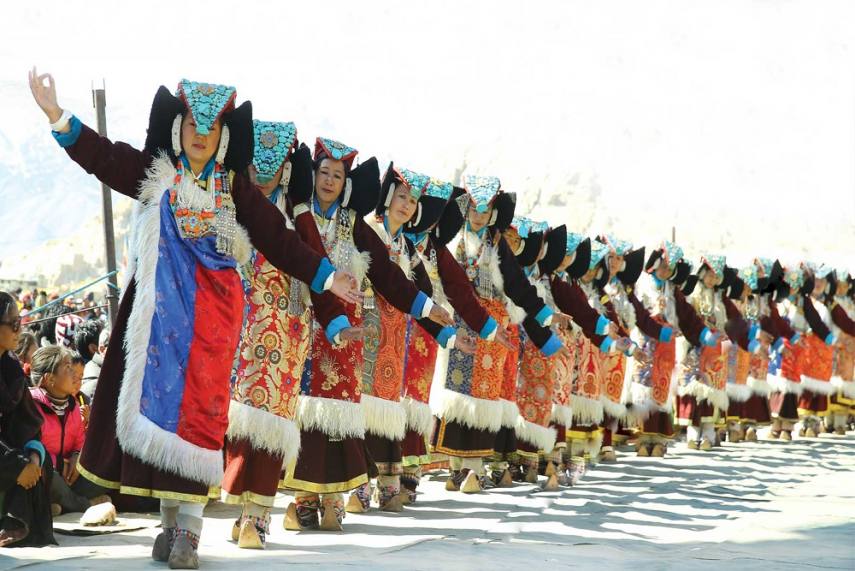
Leh Ladakh is a magnificent area that has long been known for its vibrant fairs, joyful festivals, and events for tourists. Leh Ladakh Travel Packages is incomplete without taking part in at least one of these typical feats in the form of events in the city of Leh. Beginning with Losar, Ladakh’s new year, every significant event in the local community is transformed into a major celebration, resulting in a carnival. Dances of Ladakh are the most unique culture dances that are performed on various occasions such as birthday celebrations, flowering period, marriage ceremony, Ladakh festival, harvesting period, and festivals of various monasteries are just a few of the notable crucial fairs and parties that take place in Ladakh.
List of Top Dances of Ladakh
Like many varieties of Tibetan music, the music of Ladakhi monastery celebrations often includes chanting as an intrinsic element of the religion. In the past, there were 360 different types of dances, but as a leading Travel Agents in Mumbai, we listed only a few which are still practiced now.
Jabro Dance
Jabro is one of the traditional dances of Ladakh performed by Tibetan nomads who live in the Changtheng region of Ladakh’s hillsides. This dance is performed by both men and women at all happy occasions, and it is an important feature of the Tibetan New Year’s Losar celebrations.
The Cham Dance
The cultural mask dancing, which depicts old incidents from the life of 9th-century Nyingmapa educator Padmasambhava, is one of the most famous tourist attractions of the Tsechu event. Many people name this cloaked Ladakh Dancing Cham Dancing, and it is said to bring good luck to those who see it. Cham dancing is a hidden and costumed dance that is performed as part of Buddhist festivities in Ladakh.
Chhams is one of the devotional dances of Ladakh performed by lamas (monks) at monastery festivals, where it is choreographed to the music of the Monastic Orchestra. Every monastic community has its own orchestra. The dancers wear magnificent silk costumes symbolizing many divinities from the Buddhist pantheon, as well as ornate masks ranging from the frightening and ugly to the attractive. Chhams are not for fun, but for spiritual purposes, requesting blessings to ward off evil.
The Dungchen (long hornNga (drums), ), Gyaling (oboe), Silnyen/bubjal (cymbals), dung (conch shells), Damaru (skull drums), kangling (shinbone trumpets), and Drilbu (skull drums) are among the musical instruments used to accompany the Chhams (bells). The masked dancers move slowly; the mask, not the dancing, is the most important component of the performance. All dances culminate in the triumph of good over evil. The dances are done as offerings to the monastery deity as well as to signify the annihilation of evil.
Lamas and monks at the abbeys perform the most beautiful dances in Ladakh. These efficiencies have a spiritual and mysterious ambiance surrounding them, as well as a large number of Tantrik performances.
Cham Dance
The Cham Dance’s spiritual value is found in its efficiency. The tradition matches the secluded lifestyle because the dancing focuses on routines of reflection, hand movements, incantations, invocation of divine entities, and the impact it has on bad energy destruction. The monks, dressed in vibrant colours and using magnificent hats and masks, take on the roles of celestial beings and demons, staging a mock-battle with excellent dominating wickedness.
Tukhstanmo dance & Spao dance
The Tukhstanmo is one the very famous dances of Ladakh. The Tukhstanmo dance originated in the Zanskar and Bakhamul regions, whereas the Spao dance is related with military stories. Loshon and Shoudol dances include: – The Loshon dance is a traditional Shey village harvest celebration dance.
Loshon Dance & Shoudol dance
Locals celebrate the harvest festival at Shey town by doing Loshon dancing. Ladakhi Shondol, Ladakh’s royal dance, has made history by becoming the world’s largest Ladakhi dance, according to the Guinness Book of World Records. Shondol dance, also known as the royal dance, was once performed for the King of Ladakh by artists.
Shon Dance
The Shon Dance is a royal Ladakh dance that is performed in front of the King. The Shon dance is a Ladakh royal tradition. Originally a dance performed in honour of the Ladakh royalty, it is today performed without restrictions.
Phyang Tsedup Festival
The Phyang Tsedup Event takes place on the second and third days of the Tibetan Calendar’s 6th month, which normally falls in July or August. The celebration is known for the interest, enthusiasm, and continual grinning faces of the monks who uplift the air and aura of the area.
Bacha Nagma Dance
Nagma Bacha Dancing is quite popular at weddings and other cultural occasions. The gown worn by Kathak professional dancers is similar to the attire worn by the audience. It’s a group dance with only one diva.
Now book your Ladakh tour package from Chennai with us.






